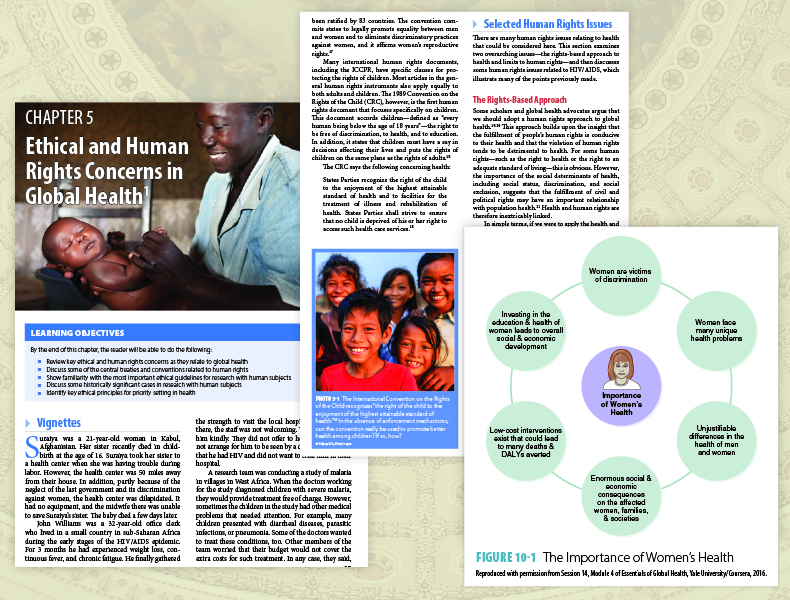The fourth edition of Global Health 101 builds on the successes of earlier editions and will, hopefully, be just as well received and useful to faculty and students as the early editions.
The outline of the book is essentially the same as the third edition, with three exceptions. First, the previous chapter on Determinants of Health and the Global Burden of Disease has now been broken into two chapters. This allows a greater focus on each of these critical topics. Second, the chapter on Intersectoral Approaches that was added in 2018 as a bonus chapter to the book is now an integral part of it. Third, the two career chapters, Working in Global Health and Profiles of Global Health Actors, will now be “bonus chapters” available electronically to everyone who purchases the book.
In addition, the fourth edition of the book focuses more on several key themes – Universal health coverage (UHC), ethical priority setting, and the quality of care – which are now organizing principles for the entire book. Faculty can build on this to ensure students understand the concept of UHC, how low- and middle-income countries might achieve it, and how all key interventions can be embedded in UHC. The treatment of “fairness” in priority setting throughout the text will help faculty keep ethics, fairness, and the fair distribution of health central to their courses. The same should be true for the quality of care, which is critical but has mostly been neglected in learning materials on global health.
The fourth edition also includes data on the burden of disease that has been updated to at least 2016. It also shows most key data both by World Bank Region and by World Bank Country Income Group. This will give faculty the opportunity to work with the data in a broad range of ways, as well as to shed more light on negative and positive outliers.
Global Health 101, Fourth Edition takes account of the policy and program recommendations of the recently completed 9-volume Disease Control Priorities in Developing Countries, Third Edition (DCP3). This includes not only the inclusion of proposed interventions but also suggestions about the platforms from which they can most effectively and efficiently be delivered. These platforms include the level of the household, community, health center, regional hospital, or referral hospital. Showing interventions this way will allow faculty to probe the feasibility and possible impacts of possible interventions in a manner that would be much more difficult without this approach.
The new edition strengthens the already extensive treatment of the health of women broadly speaking, in a way that goes beyond just reproductive health and the treatment of health disparities. This and the treatment of women and disparities in other chapters should help faculty highlight the health of women as it relates to a range of issues, such as nutrition, communicable diseases, non-communicable disease, and injuries. This can help overcome the gap in most global health literature that focuses only on women’s reproductive health.
 Global Health 101, Fourth Edition also enhances the coverage of young people and young adults by expanding the chapter on adolescents to include young adults. This follows a global trend. Adolescents and young adults are a critical group. They have unique health issues and a failure to enable their health will cause the gains in early child health to be lost. It will also lead to unhealthy adults. Yet, most teaching materials say little about this group. Global Health 101, Fourth Edition, provides what you need to engage your students in an age group that is also of immense importance to them.
Global Health 101, Fourth Edition also enhances the coverage of young people and young adults by expanding the chapter on adolescents to include young adults. This follows a global trend. Adolescents and young adults are a critical group. They have unique health issues and a failure to enable their health will cause the gains in early child health to be lost. It will also lead to unhealthy adults. Yet, most teaching materials say little about this group. Global Health 101, Fourth Edition, provides what you need to engage your students in an age group that is also of immense importance to them.
The new edition of Global Health 101 also includes more than 60 full-color photos. Many of these are from an award-winning photographer. The photos represent an opportunity for faculty to make a range of topics more “real” and more vivid. Moreover, each photo includes not only a caption but also discussion questions related to the theme of the photo. These can assist faculty in using the photos for deepening their engagement with students on key themes.
Global Health 101, Fourth Edition also comes with an extraordinary array of ancillary materials that are meant to enhance teaching and learning and save faculty substantial amounts of time that they might otherwise spend developing such materials themselves. Some of these are meant for faculty, some for learners, and some for both.
These materials include:
- model syllabi
- model mid-term and final examinations
- quiz questions
- PPTs for each chapter
- a global health reference list
- a list of global health websites
- a list of global health videos
- a list of global health massive open online courses (MOOCs)
- discussion cases on key themes
